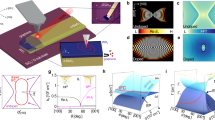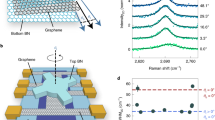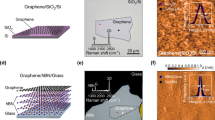Abstract
Hexagonal boron nitride (h-BN) is a natural hyperbolic material1, in which the dielectric constants are the same in the basal plane (εt ≡ εx = εy) but have opposite signs (εtεz < 0) in the normal plane (εz)1,2,3,4. Owing to this property, finite-thickness slabs of h-BN act as multimode waveguides for the propagation of hyperbolic phonon polaritons1,2,5—collective modes that originate from the coupling between photons and electric dipoles6 in phonons. However, control of these hyperbolic phonon polaritons modes has remained challenging, mostly because their electrodynamic properties are dictated by the crystal lattice of h-BN1,2,7. Here we show, by direct nano-infrared imaging, that these hyperbolic polaritons can be effectively modulated in a van der Waals heterostructure8 composed of monolayer graphene on h-BN. Tunability originates from the hybridization of surface plasmon polaritons in graphene9,10,11,12,13 with hyperbolic phonon polaritons in h-BN1,2, so that the eigenmodes of the graphene/h-BN heterostructure are hyperbolic plasmon–phonon polaritons. The hyperbolic plasmon–phonon polaritons in graphene/h-BN suffer little from ohmic losses, making their propagation length 1.5–2.0 times greater than that of hyperbolic phonon polaritons in h-BN. The hyperbolic plasmon–phonon polaritons possess the combined virtues of surface plasmon polaritons in graphene and hyperbolic phonon polaritons in h-BN. Therefore, graphene/h-BN can be classified as an electromagnetic metamaterial14 as the resulting properties of these devices are not present in its constituent elements alone.
This is a preview of subscription content, access via your institution
Access options
Subscribe to this journal
Receive 12 print issues and online access
$259.00 per year
only $21.58 per issue
Buy this article
- Purchase on Springer Link
- Instant access to full article PDF
Prices may be subject to local taxes which are calculated during checkout



Similar content being viewed by others
References
Dai, S. et al. Tunable phonon polaritons in atomically thin van der Waals crystals of boron nitride. Science 343, 1125–1129 (2014).
Caldwell, J. D. et al. Sub-diffractional volume-confined polaritons in the natural hyperbolic material hexagonal boron nitride. Nature Commun. 5, 5221 (2014).
Guo, Y., Newman, W., Cortes, C. L. & Jacob, Z. Applications of hyperbolic metamaterial substrates. Adv. Optoelectron. 2012, 452502 (2012).
Poddubny, A., Iorsh, I., Belov, P. & Kivshar, Y. Hyperbolic metamaterials. Nature Photon. 7, 948–957 (2013).
Dai, S. et al. Subdiffractional focusing and guiding of polaritonic rays in a natural hyperbolic material. Nature Commun. 6, 6963 (2015).
Novotny, L. & Hecht, B. Principles of Nano-Optics (Cambridge Univ. Press, 2006).
Xu, X. G. et al. One-dimensional surface phonon polaritons in boron nitride nanotubes. Nature Commun. 5, 4782 (2014).
Geim, A. K. & Grigorieva, I. V. Van der Waals heterostructures. Nature 499, 419–425 (2013).
Ju, L. et al. Graphene plasmonics for tunable terahertz metamaterials. Nature Nanotech. 6, 630–634 (2011).
Chen, J. et al. Optical nano-imaging of gate-tunable graphene plasmons. Nature 487, 77–81 (2012).
Fei, Z. et al. Gate-tuning of graphene plasmons revealed by infrared nano-imaging. Nature 487, 82–85 (2012).
Fang, Z. et al. Active tunable absorption enhancement with graphene nanodisk arrays. Nano Lett. 14, 299–304 (2014).
Gerber, J. A., Berweger, S., O'Callahan, B. T. & Raschke, M. B. Phase-resolved surface plasmon interferometry of graphene. Phys. Rev. Lett. 113, 055502 (2014).
Cai, W. & Shalaev, V. Optical Metamaterials: Fundamentals and Applications (Springer, 2010).
Fiori, G. et al. Electronics based on two-dimensional materials. Nature Nanotech. 9, 768–779 (2014).
Xia, F., Wang, H., Xiao, D., Dubey, M. & Ramasubramaniam, A. Two-dimensional material nanophotonics. Nature Photon. 8, 899–907 (2014).
Brar, V. W. et al. Hybrid surface-phonon–plasmon polariton modes in graphene/monolayer h-BN heterostructures. Nano Lett. 14, 3876–3880 (2014).
Xu, X. G. et al. Mid-infrared polaritonic coupling between boron nitride nanotubes and graphene. ACS Nano 8, 11305–11312 (2014).
Woessner, A. et al. Highly confined low-loss plasmons in graphene–boron nitride heterostructures. Nature Mater. 14, 421–425 (2015).
Fei, Z. et al. Infrared nanoscopy of dirac plasmons at the graphene–SiO2 interface. Nano Lett. 11, 4701–4705 (2011).
Wunsch, B., Stauber, T., Sols, F. & Guinea, F. Dynamical polarization of graphene at finite doping. New J. Phys. 8, 318 (2006).
Kumar, A., Low, T., Fung, K. H., Avouris, P. & Fang, N. X. Tunable light–matter interaction and the role of hyperbolicity in graphene–hBN system. Nano Lett. 15, 3172–3180 (2015).
Hwang, E. H., Sensarma, R. & Das Sarma, S. Plasmon–phonon coupling in graphene. Phys. Rev. B 82, 195406 (2010).
Yan, H. et al. Damping pathways of mid-infrared plasmons in graphene nanostructures. Nature Photon. 7, 394–399 (2013).
Liu, Z., Lee, H., Xiong, Y., Sun, C. & Zhang, X. Far-field optical hyperlens magnifying sub-diffraction-limited objects. Science 315, 1686 (2007).
Li, P. et al. Hyperbolic phonon–polaritons in boron nitride for near-field optical imaging. Preprint at http://arXiv.org/abs/1502.04093 (2015).
Hoffman, A. J. et al. Negative refraction in semiconductor metamaterials. Nature Mater. 6, 946–950 (2007).
Jacob, Z., Alekseyev, L. V. & Narimanov, E. Optical hyperlens: far-field imaging beyond the diffraction limit. Opt. Express 14, 8247–8256 (2006).
Smith, D. R., Schurig, D., Mock, J. J., Kolinko, P. & Rye, P. Partial focusing of radiation by a slab of indefinite media. Appl. Phys. Lett. 84, 2244–2246 (2004).
Vakil, A. & Engheta, N. Transformation optics using graphene. Science 332, 1291–1294 (2011).
Kadic, M. et al. Transformation plasmonics. Nanophotonics 1, 51 (2012).
Iorsh, I. V., Mukhin, I. S., Shadrivov, I. V., Belov, P. A. & Kivshar, Y. S. Hyperbolic metamaterials based on multilayer graphene structures. Phys. Rev. B 87, 075416 (2013).
Goos, F. & Hänchen, H. Ein neuer und fundamentaler Versuch zur Totalreflexion. Ann. Phys. 436, 333–346 (1947).
Acknowledgements
Work at the University of California, San Diego (UCSD), on optical phenomena in vdW materials is supported by DOE-BES DE-FG02-00ER45799 and the Moore Foundation. Research at UCSD on metamaterials and the development of nano-infrared instrumentation is supported by the Air Force Office of Scientific Research (AFOSR), the University of California Office of The President and the Office of Naval Research. P.J-H. acknowledges support from the AFOSR (grant no. FA9550-11-1-0225).
Ethics declarations
Competing interests
F.K. is one of the cofounders of Neaspec and Lasnix, producer of the s-SNOM and infrared source used in this work. All other authors declare no competing financial interests.
Supplementary information
Supplementary information
Supplementary Information (PDF 1015 kb)
Rights and permissions
About this article
Cite this article
Dai, S., Ma, Q., Liu, M. et al. Graphene on hexagonal boron nitride as a tunable hyperbolic metamaterial. Nature Nanotech 10, 682–686 (2015). https://doi.org/10.1038/nnano.2015.131
Received:
Accepted:
Published:
Issue Date:
DOI: https://doi.org/10.1038/nnano.2015.131
This article is cited by
-
Planar hyperbolic polaritons in 2D van der Waals materials
Nature Communications (2024)
-
Confocal nonlinear optical imaging on hexagonal boron nitride nanosheets
PhotoniX (2023)
-
Hyperbolic polaritonic crystals with configurable low-symmetry Bloch modes
Nature Communications (2023)
-
Observation of directional leaky polaritons at anisotropic crystal interfaces
Nature Communications (2023)
-
Electron cooling in graphene enhanced by plasmon–hydron resonance
Nature Nanotechnology (2023)



